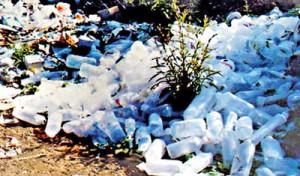
CEA to ban PET bottles under one litre
By Chrishanthi Christopher
Discarded plastic bottles creating environmental problems
The Central Environment Authority (CEA) is to ban the sale of carbonated drinks and fruit juices in PET (PolyEthylene Tetraphthalate ) bottles below 1 litre, to control the plastic menace in the country.
CEA Waste Management Director, J.M.U. Indraratne said that, instead, the Beverage industry will be encouraged to sell drinks in glass bottles. However, the industry could use PET bottles of 1 litre or more, for their beverages. Water will be exempted from the law.
He said this would minimise environmental problems caused by plastics. It is also intended to curb haphazard disposal of and burning plastic bottles, causing health hazards, together with economic and social problems.
The CEA, at the end of the 2016 Siripada season, collected 5.5 tons of PET bottles and 830 kg of plastic waste.
In a Polythene/Plastic and Electronic Waste Prevention Week in October last year, involving all Districts, the CEA collected 71.59 tons of plastic/polythene and 440.38 tons of e-waste, with Colombo contributing the highest of 222,738 kg of e-waste and 9,225 kg of plastic/polythene, while Mullaitivu contributed 845 kg of e-waste and 165 kg of plastic/polythene.
Mr Indraratne said that plastics was losing its value in the world market. He said 1 kg of recyclable plastic earlier fetched up to Rs 46 per kg but now, it has come down to Rs 6 per kg. Consequently, many people who collected and sold used plastic bottles, have abandoned the trade.
The CEA says the use of glass bottles, while greatly reducing the amount of discarded bottles, will also have a recycle value.
Additionally, the CEA will also ban the import of recycled raw material and the sale of lunch sheets below 40 microns, in the local market.
At a CEA Expert Committee meeting in November 2016, officials from the CAA, Ministry of Health, university Researchers and industrialists related to plastic manufacture discussed a future action plan for a national policy to manage plastic, by initially doing away with lunch sheets, and then increasing the thickness of shopping bags to 40 microns.
Mr Indraratne said a Cabinet paper will be submitted for approval, soon.
Advisory Committee Chairman, Anton Hemantha said that, “However, the Packaging industries were not consulted in the decision making. He opined that, banning PET bottles below 1 litre capacity, will be disastrous for the Beverage market.
He said PET bottles are very handy with soft drinks and yoghurt packaged in economic PET bottles. Moreover, thousands of tourists visiting the country opt for the PET bottled drinks. “We need economical plastic bottles,” he said.
“We need lunch sheets to wrap takeaway food and shopping bags over 40 microns will be costly. Supermarkets will pass the buck to the customer,” he said.
To produce high density polyethylene for shopping bags, more raw material has to be imported with extra money spent on it. Currently, 1,400 metric tonnes of raw material is imported. Again the disposal of the thicker gauge will prove even more difficult.
Mr Hemantha conceded that, while the world is going in one direction, producing thinner gauge plastic, Sri Lanka is taking a u-turn.
“The way the CEA is going it is not going to work. The only solution is re-cycling. Collect and add value to the plastic waste.”
A PET bottle manufacturing company for leading brands of carbonated drinks and fruit juices said the ban on economy sized PET bottles will have an adverse impact on the economy.
They said the economy bottles are for third world countries, whose people cannot afford the big bottle. The Packaging industry will support the government, if it comes forward with a proper mechanism for the disposal of plastics. It was argued that, substituting glass bottles will only create additional weight, cumbersome handling and increased transport cost.
Source-19/03/2017, The Sunday Times , See more at – http://www.sundaytimes.lk/170319/news/cea-to-ban-pet-bottles-under-one-litre-233500.html
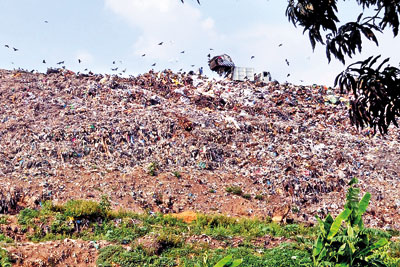
Biggest garbage generator tries to put house in order
Waste collected in the Colombo Municipality area still continues to be transported to the Meethotamulla site despite public protests. Pic by Indika Handuwala
By Akash Widanapathirana
In the Western Province, where more than 60 per cent of Sri Lanka’s waste is generated, police and military will be keeping an eye on the streets for reckless garbage disposal.
A team has been tasked with reporting mismanagement of garbage to the relevant authorities.
Lawsuit filed by Environment Police have increased three-fold.
Senior DIG of the Western Province, Nandana Munasinghe said: “We make field visits in the morning and and action is taken if garbage is dumped on the roads. However the contribution of the people is not sufficient in this regard.”
According to the Waste Management Authority, between 7,000 metric tonnes and 7,500 metric tonnes of solid waste are generated in Sri Lanka per day. The Colombo District alone generates 2,000-2,100 MT.
However, only 50-60 per cent of the garbage generated island-wide are collected by local authorities.
Nearly 800-850 MT of solid waste are transported to the Meethotamulla site by the Colombo Municipality Council and the Kolonnawa Urban Council.
The Western Province accounts for more than 60 per cent of waste generation in the country.
It will only get worse. The Ministry of Megapolis and Western Development has forecast that by 2030, the megapolis and the off-shore port city luxury residential project will generate another 1,300 MT a day.
Dr Upali Indrasiri, project director of the presidential task force on environment protection, told the Sunday Times there are plans for the future.
Projects to convert waste to energy will be launched in Muthurajawela, Karadiyana, and Kaduwela, Bomiriya.
Karadiyana has an expected capacity of 1,000 MT per day and in Muthurajawela it will be 630 MT per day. Dr Indrasiri said discrepancies related to the feed-in-tariff rate for the generated power that caused a significant delay in the implementation of the project, has now been solved.
The Bloemendhal waste site will be transformed into a mix of commercial areas, an urban forest patch, and a recreational park.
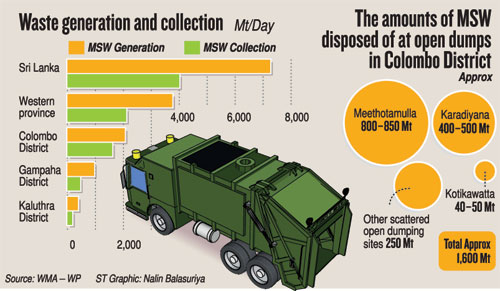
A report by the Ministry of Megapolis and Western Development says that sanitary land fills will be created in Malamulla, Divulapitiya, and a bio gas project will be initiated in Dikkovita.
Meanwhile, Sidath Nilanga, health supervisor in the Dompe Divisional Secretariate said recycling of garbage that began a few years back has been
successful.
He said about 10 MT of garbage are collected every day in the Dompe area and 3 MT were used for compost production.
“One metric tonne of compost can be produced from that although sometimes it may take 2-3 weeks depending on factors such as rainfall, and humidity.” He said there was good demand for compost.
“There have been instances when five MT of compost were requested at once. But our production is low.” He said that a sanitary landfill system is managed for waste that cannot be recycled or used for compost production.
“Plastic and polythene are dumped in a separate pit.’’
He said the pit has a capacity of 90 MT a day and only 10 MT of garbage is received. But he stressed that a sanitary landfill is only a short term solution.
A. T. U. Kularathna, public health inspector in the Kaduwela Municipality Council, also said bio degradables are used for compost and bio-gas production while plastics, glass and polythene are recycled through machinery provided by the Central Environment Authority.
“We earn some revenue from recycling and compost manufacturing. We distribute it among the workers who collect the garbage from households and companies. It is a kind of motivation for them as well,” he said.
| Wellawatte, Mattakkuliya worst offendersWaste collected in the Colombo Municipality area still continue to be transported to the Meethotamulla site despite public protests.The deputy director of solid waste management at the Colombo Municipal Council said 750-850 metric tonnes of waste are collected per day. Some of the waste is sold to recyclers while the rest is transported to the Meethotamulla.
She said that although the garbage sent to Meethotamulla includes a large amount of organic waste, it cannot be turned into compost because there is no site for the purpose. If garbage is separated, the amount of waste collected could be reduced by 100 MT per day, she claimed. But she said there is little effort by the people to separate their waste. Residents in Mattakkuliya, Wellawatta and north Colombo are the worst offenders when it comes to not separating their waste, she said. Source -19/03/2017,The Sunday Times, See more at – http://www.sundaytimes.lk/170319/news/biggest-garbage-generator-tries-to-put-house-in-order-233363.html |
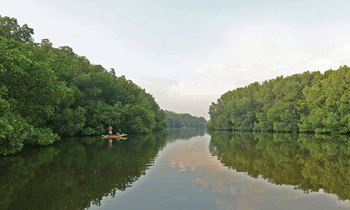
US conservation group wins $1m grant for SL project.
BERKELEY, California —A Berkeley-based organization- Seacology-has won a grant of almost $1 million for a conservation project in Sri Lanka.
The Berkeley-based organization is a winner in this year’s Water Window Challenge sponsored by the international Global Resilience Partnership.
A goal of the competition is to bolster the resilience of flood-prone communities in Central and East Africa and South and Southeast Asia against climate change and natural disasters.
Seacology’s Sri Lanka Mangrove Conservation Project aims to protect the Indian Ocean island nation’s remaining mangrove forests, replant thousands of acres of deforested coastline, and offer microloans and business training to tens of thousands of disadvantaged women who otherwise would cut down mangroves to sell as charcoal, according to a news release.
The project is in collaboration with the local non-governmental organization Sudeesa, also known as Small Fishers Federation of Sri Lanka. “This project makes Sri Lanka the first nation in the world to protect all of its mangrove forests,” Duane Silverstein, Seacology’s executive director, said in the release.
“This is very important as mangroves sequester more carbon than other forests and thus play a vital role in the battle against global warming.”
The grant will allow Seacology to expand the project to northern and eastern portions of Sri Lanka that were disproportionately impacted by a 26-year-long civil war, fueled by ethnic tensions between the nation’s Buddhist Sinhalese majority and Hindu Tamil minority, that was officially proclaimed ended in 2009.(East Bay Times).
Source – 18/03/2017,Dailymirror, See more at: http://www.dailymirror.lk/article/US-conservation-group-wins-m-grant-for-SL-project-125732.html#sthash.pOlpt3Ss.dpuf

Tips to reduce Carbon emissions in day-to-day lives
Global warming is caused by the emission of greenhouse gases and 72% of the totally emitted greenhouse gases are Carbon dioxide (CO2). Carbon emissions are a direct contributor to global warming and the numbers are getting higher by the day. Carbon dioxide emissions therefore are the most important cause of global warming. CO2 is inevitably created by burning fuels like such as oil, natural gas, diesel, organic-diesel, petrol, organic-petrol and ethanol. The emissions of CO2 have been dramatically increased within the last 50 years and are still increasing by almost 3% each year. Following are a few ways in which you could possibly reduce Carbon emissions during your daily activities.
Driving
Alternatives to driving – When possible, walk or ride your bike in order to avoid carbon emissions completely. Carpooling and public transportation drastically reduce CO2 emissions by spreading them out over many riders.
Drive a low carbon vehicle – High mileage doesn’t always mean low CO2 emissions. All vehicles have an estimated miles-per-gallon rating. Electric cars emit no CO2 if they’re charged with clean electricity.
Driving style – Speeding and unnecessary acceleration reduce mileage by up to 33%, waste gas and money, and increase your carbon footprint.
Tire inflation and other tuning- Properly inflated tires improve your gas mileage by up to 3%. It also helps to use the correct grade of motor oil, and to keep your engine tuned, because some maintenance fixes, like fixing faulty oxygen sensors, can increase fuel efficiency by up to 40%.
Avoid traffic– Being stuck in traffic wastes gas and unnecessarily creates CO2. Use traffic websites and apps and go a different way or wait.
Home
Appliances – Make energy efficiency a primary consideration when choosing a new furnace, air conditioning unit, dishwasher, or refrigerator.
Lighting -Turn off lights you’re not using and when you leave the room. Replace incandescent light bulbs with compact fluorescent or LED ones.
Solar – Add solar panels to the roof of your home. This costs a little more than the above options, but many providers offer financing options which minimize upfront costs.
Food
Eat locally-produced and organic food – It has been estimated that 13% of U.S. greenhouse gas emissions result from the production and transport of food. Transporting food requires petroleum-based fuels, and many fertilizers are also fossil fuel-based.
Other uses
Water usage – Lower the amount of energy used to pump, treat, and heat water by washing your car less often, using climate-appropriate plants in your garden, installing drip irrigation so that plants receive only what they need, and making water-efficient choices when purchasing shower heads, faucet heads, toilets, dishwashers and washing machines.
Reuse and recycle – It has been estimated that 29% of U.S. greenhouse gas emissions result from the “provision of goods,” which means the extraction of resources, manufacturing, transport, and final disposal of “goods” which include consumer products and packaging, building components, and passenger vehicles, but excluding food. By buying used products and reselling or recycling items you no longer use, you dramatically reduce your carbon footprint from the “provision of goods.”
Support clean energy sources – Whenever you can, advocate for clean alternatives to fossil fuels, such as wind, solar, geothermal, and appropriately designed hydroelectric and biomass energy projects.
With the increase in the number of vehicles on the streets, traffic has become a major problem in Sri Lanka today. Such traffic congestions would result in CO2 emissions and therefore it is advisable to use alternative methods of transport during such times. As the country is quite concerned on sustainable development, it is important to note that there are several commercial entities willing to help you in this process. United Tractors is one such source that specialises in distributing electric power in Sri Lanka. Today, many of the biggest buildings and industrial facilities in the country are powered by Cat generators. The most power dependent institutions such as hospitals and 5 star hotels too rely on Cat power.
Source – 15/03/2017, Dailymirror,See more at: http://www.dailymirror.lk/article/Tips-to-reduce-Carbon-emissions-in-day-to-day-lives-125520.html#sthash.O6fzQ3Rk.dpuf
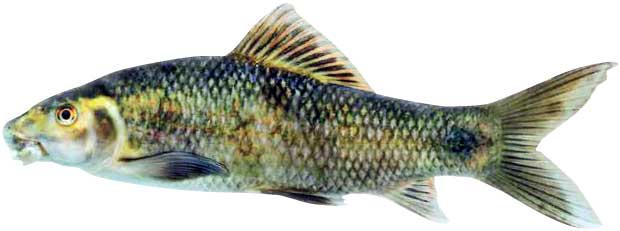
Hydropower vs endangered fish CEB’s proposed hydropower project a threat to endangered species.
The Ceylon Electricity Board (CEB) is planning to add 85 Gw annual output to the country’s electricity supply, with the proposed Moragolla hydro power project. It is a threat to the green Labeo (Labeo fisheri), a critically endangered fish species that lives in that part of the Mahaveli river, where the Moragolla hydro power station is to be located.
The Environmental Impact Assessment (EIA) was done by the CEB and the Central Environment Authority (CEA) approved the report. The project began and dynamite was being used.
It was then that the dead Labeo fish were detected, until then, they were considered extinct. The project was halted with this discovery, it was revealed that the CEB had not informed the Department of Wildlife Conservation (DWC) of this and the National Aquatics Resources Association (NARA) was instructed to carry out a study to find out whether more Labeo fish are in there. The fish species was to be translocated to the Kelani river in Kitulagala area. It seemed DWC, CEA and NARA are passing the responsibility to each other, as it was evident from their comments.
The Asian Development Bank (ADB) was to give a 120 Million loan for the relocation of Labeo fish.
According to senior scientist Ramani Shirantha of NARA, the relocation is not going to happen. In that case, what happens to the ADB loan? Nobody knows who got the loan. Every institution related to this is silent when questioned about it.
Moragolla project manager of CEB, Jayarathna, made it clear that nobody could give information without the chairman’s permission. He blatantly said he cannot say anything without written permission and cut the line. We would like to remind all those officers who take cover behind such flimsy excuses that, with the Right to Information Act (RTI act), the public are entitled to information from public officials.
It appears that the government institutions and officials are not well aware of the projects they are carrying out. The responsible people in higher posts are being ignorant, even when they can find solutions to protect nature whilst exploiting for the benefit of the country. The experts must be imaginative enough to find a solution which can protect nature as well as development activities.

“Major hydro projects, blast fishing and mini hydros threaten the Gadaya.”
– Madhura De Silva President of Wildlife Conservation Society, Galle
- This critically endangered species presently remains in the untouched part of Mahaweli river
- Major hydro projects, blast fishing and mini hydros are the threats to Gadaya.
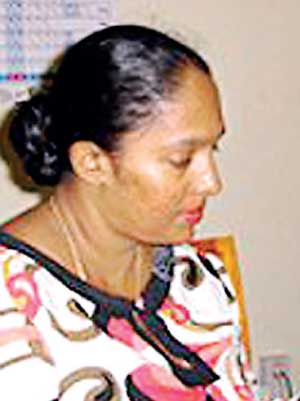 Commenting on the relocation plan on Green Labeo (locally known as Gadaya), Madhura De Silva said the Green labeo lived in rapidly flowing rivers and it is restricted to Mahaweli basin. This species feeds on algae growing on rock surfaces and they prefer fast flowing water. Green Labeo dislikes the stagnant water and stays in the deep waters, where rocks are common. Fast water flow is crucial to their existence. This critically endangered species presently remains in the untouched part of Mahaweli river. In those areas in the Mahaweli basin, where major hydro power plants — Victoria, Randenigala and Rantambe — the damming has changed their migration patterns and the Green labeo are in trouble as they swim upstream to breed. With damming, up stream swimming is impossible and their migration patterns have been
Commenting on the relocation plan on Green Labeo (locally known as Gadaya), Madhura De Silva said the Green labeo lived in rapidly flowing rivers and it is restricted to Mahaweli basin. This species feeds on algae growing on rock surfaces and they prefer fast flowing water. Green Labeo dislikes the stagnant water and stays in the deep waters, where rocks are common. Fast water flow is crucial to their existence. This critically endangered species presently remains in the untouched part of Mahaweli river. In those areas in the Mahaweli basin, where major hydro power plants — Victoria, Randenigala and Rantambe — the damming has changed their migration patterns and the Green labeo are in trouble as they swim upstream to breed. With damming, up stream swimming is impossible and their migration patterns have been
badly affected.
According to Madhura De Silva, three major factors have been identified as working against the existence of Gadaya. Major hydro projects, blast fishing and mini hydros are the threats to Gadaya. People in Kandy use explosives to harvest fish and the remaining Peradeniya, Gatambe and Galaha areas are subjected to development (human settlements).
“In the lower Knuckles area, people use dynamite in deep pools to harvest fish and this affects the whole population including juvenile and adult fish and the entire fish population,” he explained.
Evaluating the relocation of Green labeo he emphasized the practical difficulties. It is hard to catch this fish species without harming them because they live so deep. Scuba divers with oxygen supply are needed to catch the fish in habitat and that’s really difficult.”
“We accept that energy is necessary, but at what cost?”
– Dr. Sewwandi Jayakody Ecologist and senior lecturer in Wayamba University
- When we were aware that the CEB was calling for tenders to relocate Labeo fish, we sent a letter to DWC asking the details of relocation
- Regarding how many of this species are going to be relocated, they are clueless
“At the very beginning of this hydro power project there was no record of Labeo fish in this area. When we were aware that the CEB was calling for tenders to relocate Labeo fish, we sent a letter to DWC asking the details of relocation assessments and about the species. Yet the DWC never sent a reply,” Dr. Jayakody said.
Dr Sewwandi described the Labeo fish as a deep pool inhabiting creature. In those deep pools, the oxygen percentage is really high and it’s a biological need of the fish species. Their habitats are places where rivers fall from one level to the other and this characteristic is necessary for the species existence.
“The DWC has not yet identified some important facts as in which river they live and their population numbers; regarding how many of this species are going to be relocated, they are clueless. Now they are going to relocate this critically endangered fish species in to Kelani Ganga – Kitulgala area. NARA is doing this. If this relocation is not successful, we ourselves are driving them to extinction. We accept that energy is necessary, but at what cost? Do you really need to relocate them because of that?,” she asked.

“This activity will be illegal under the section 23 A A of National Environment Act.”
– Jagath Gunawardena Environment lawyer
- This is a species that hadn’t been studied very much in Sri Lanka and therefore any capture or any attempt to relocate would be disastrous to this population
- Gadaya or the Green Labeo (Labeo fisheri), is included as a protected species under Section 31 A of Fauna and Flora Protection Ordinance
- Ulcerative Fish Disease is present in the Kelani river
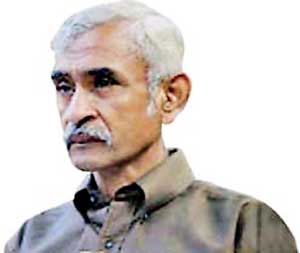 “Gadaya or the Green Labeo (Labeo fisheri), is included as a protected species under Section 31 A of Fauna and Flora Protection Ordinance. Therefore, no one can capture, harm, kill or keep in custody or under one’s possession any living individual of this species,” he said on the legal background of the matter.
“Gadaya or the Green Labeo (Labeo fisheri), is included as a protected species under Section 31 A of Fauna and Flora Protection Ordinance. Therefore, no one can capture, harm, kill or keep in custody or under one’s possession any living individual of this species,” he said on the legal background of the matter.
“According to the provisions of FFPO, the director of Wildlife Conservation can allow the capture of a protected species of fish only for scientific researches which include conservation purposes. Therefore, any attempt by NARA to catch it and trying to relocate it is illegal and even the director of DWC cannot give permission for such an operation.” he claimed.
“The proposed relocation of the species is not included in the permitted activities as per the environment approval granted by the CEA, for this project. Therefore, this activity will be illegal under the section 23 A A of National Environment Act. This is a species that hadn’t been studied very much in Sri Lanka and therefore any capture or any attempt to relocate would be disastrous to this population. It is important that a comprehensive study of this species should have been carried out before any attempted relocation. It is also very troubling to note there will be a trans-boundary relocation of this population to Kelani river from the Mahaweli Ganga. There should have been a comprehensive study of the Kelani river, including the native flora and fauna, and whether any predators or any diseases are present in the Kelani river and in the other hand whether any native animal including fish inhabiting the Kelani Ganga would be adversely affected by the newly introduced green Labeo,” he explained.
“I am personally aware, from my observations, that the Ulcerative Fish Disease is present in the Kelani river and it has affected species belonging to the family Cyprinidae to which the green Labeo too belongs. Therefore, this possibility has to be comprehensively studied.”
“We totally depend on the DWC’s position.”
– Kanthi De Silva Acting Deputy Director General of EIA Division – Central Environment Authority
- There was a supplementary EIA done in 2014
- During the construction the CEB has noted this protected species living in the area
“We are awaiting the decision of DWC, because they have the authority to take action in this matter. There was a supplementary EIA done in 2014 and at that time the hydropower project was approved by the Mahaweli Authority,” she said.
“During the construction the CEB has noted this protected species living in the area. After that, the DWC had asked NARA to carry out a proper study to find out whether this fish species lived within the site. And I have to say; we totally depend on the DWC’s position,” she added.
“We have directed NARA to do a research on the impact of relocating the species. Our decisions depend on the results of NARA research.”
– Hashini Sarathchandra Publicity officer of Department of Wildlife Conservation (DWC)
“Relocation is not happening”
– Ramani Shirantha Senior Scientist of Inland Aquatic Resources and Aquaculture Division – NARA
- I’m not aware of the ADB loan or what happens to it.
- Labeo fishery species found in Ethgala area
“The relocation is not happening because the report has revealed the Labeo fishery species is there in the Ethgala area in Mahaweli river. And we are going to write a report to DWC. The methods we used to survey the existence of fish species were underwater photographs and videos. And I’m not aware of the ADB loan, what happens to it, or what is the
exact amount.”
Depictions from EIA report that was made earlier
- Additional Environment studies report made in February 2014
- Sri Lanka Green Power Development and Energy Efficiency Improvement Investment Program
“The Ceylon Electricity Board (CEB) plans to develop a new 30.0 MW hydropower project at Moragolla in Kandy District. The scheme involves construction of a 35m high concrete gravity dam (with a 5-gate spillway) across the Mahaweli Ganga at Weliganga, to create a 38.5 ha (1.98 MCM) reservoir with a Full Supply Level (FSL) at 548 msl. “
“5.1.4 ……the presence of Labeo fisheri, locally known as “Kalu Gadeya”, a critically endangered species (MOE, (2012), is of particular interest as it is only found in the middle catchments of the Mahaweli river system (Pethiyagoda, 1991; Shirantha, 2012)….”Report of IUCN
“Conservation status of Labeo fisheri According to the National Red List 2012, Labeo fisheri is categorized as a Critically Endangered freshwater fish and is included in Schedule VI of the Fauna and Flora protection Ordinance (Amended act No. 22 of 2009) as a protected species (Gunasekara, 2011).”
(https://www.adb.org/sites/default/files/linked-documents/47037-003-eiaab-02.pdf)

Source – 16/03/2017,Dailymirror,See more at: http://www.dailymirror.lk/article/Hydropower-vs-endangered-fish-CEB-s-proposed-hydropower-project-a-threat-to-endangered-species-125598.html#sthash.C4nZz0kV.dpuf
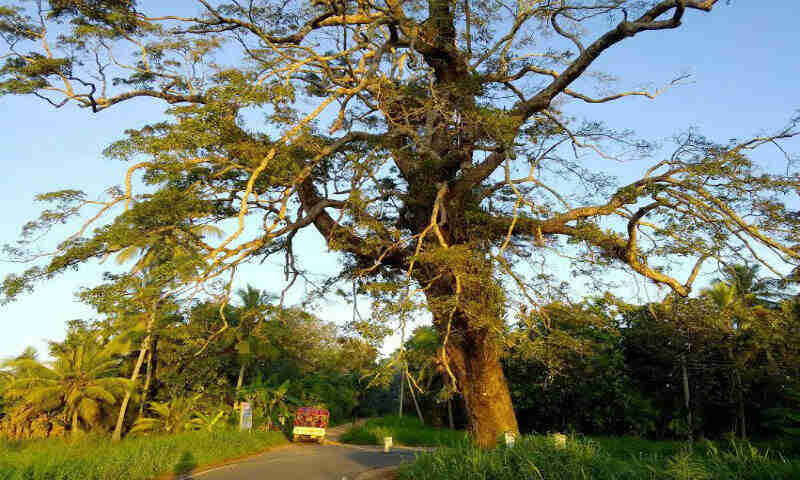
400 year old historic mee tree falls down
Image courtesy: dinamina.lk
A 400 year old mee tree (Madhuca longifolia), believed to be a place of rest for British sea captain and explorer Robert Knox, fell down on 12th March. The tree was on the bank of Nachchaduwa Kalluvila weva in Anuradhapura.
Knox made special mention of this tree in his manuscript ‘An Historical Relation of the Island Ceylon’.
The residents of the area express their dismay over the destruction of such a historic and useful tree.
Source – 14/03/2017, Front Page – See more at – http://www.frontpage.lk/page/400-year-old-historic-mee-tree-falls-down/19426
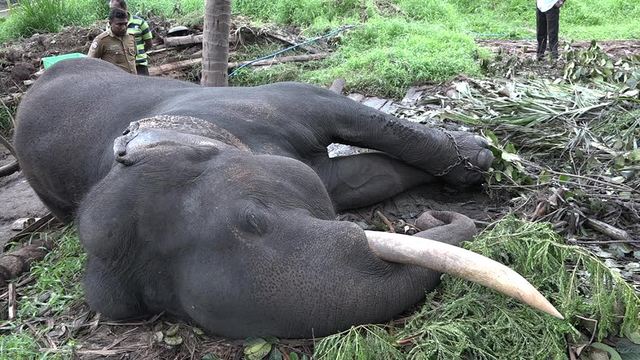
Temple of the Tooth tusker dies
mage courtesy: Gossip – Lanka News
The stately tusker ‘Eka Dantheya’ belonging to the Temple of the Tooth died yesterday (12th March). He was 47 years old, and had participated in the Kandy Esala Perahera for the last four decades.
The elephant was named Eka Dantheya since he had only his left tusk.
Veterinary surgeons and the Wildlife Officers will be conducting the autopsy and determine the cause of death.
Source – 13/03/2017, Front Page, See more at- http://www.frontpage.lk/page/Temple-of-the-Tooth-tusker-dies-/19392
Farmers Face Worst Harvest In 40 Years
Farmers are counting the cost of the nation’s worst drought in decades, which has caused widespread crop failure and food shortages while compounding the nation’s existing malnutrition crisis. Drought conditions now exist in all but two of the country’s 25 provinces, and more than 1.2 million people are affected, including over 600,000 children.
Rice paddy cultivation from the harvest just ended was down 63 per cent compared to the average, making it the worst major harvest in over 40 years. “The biggest harvest of the year has just finished and it’s been a massive failure for most farmers living in areas crippled by the drought,” said Chris McIvor, Save the Children Country Director in Sri Lanka.
Widespread food and water shortages across the country have been visible, and it could get worse if the next harvest in Yala season due in August is also below the norm. Thousands of water tanks are running low or drying out with some water stores becoming contaminated because they’ve been stagnant for too long. There have even been reports of wild elephants coming into villages in search of food and water, often destroying remaining crops and potentially putting children’s lives in danger. McIvor warned that the drought was also compounding Sri Lanka’s long struggle with malnutrition, which affects nearly a third of children and a quarter of women.
http://www.thesundayleader.lk/2017/03/12/farmers-face-worst-harvest-in-40-years/

Sinharaja in Danger
Sinharaja Rainforest
by Hafsa Sabry
Alleged illegal construction of mini hydro power plants projects in the Sinharaja Forest Reserve, a national park and a biodiversity hotspot in Sri Lanka, has caused many environmental damages to the world heritage. Sinharaja is of international significance and has been designated a Biosphere Reserve and World Heritage Site by UNESCO.
The illegal construction of the Project that crosses the Kosgulana River and along the water catchment areas of Diya Eli, Ganga Jala in the Sinharaja Forest buffer zone has caused considerable damages to the rainforest, even though the environmentalists and the Rainforest Protectors Organization raised concern over the environmental damages resulted by the project. In the meantime, the relevant authorities are being informed about the damages caused by the project, and they are accused of being silent over the law violation.
The Ministry of Power and Energy has planned to construct108 Mini Hydro Power Plants in one of the high bio-diversities of the country along Sripada, Sapthaya Kanya, Maskeliya Oya, and through Lakshapana Dam and V-Oya without any proper Environmental Impact Assessment (EIA) being conducted by the relevant authorities, while causing damages to the environment, and the water sources of the country. This construction is being carried out in the Northern Sinharaja Rainforest buffer zone at Kosgulana, approximately 4km East from Kudawa main entrance.
Ampanagala, Vevathenna, Kombarava Ganga, Dambulu Oya, Banamadu Oya, Gombarau Oya, and many lakes and water streams are being affected and damaged by this project. “The construction of this project on the basis of economic development is being carried out while ignoring the protection of nature reservoirs and the water sources of the country,” claimed Ravindra Kariyawasam, the environmentalist and Director for Center for Environmental and Nature Studies (CENS).
More than 78 Private companies will be benefited from this project of 108 mini hydro power plants to which many environmental committees have expressed concern over the environmental damages caused by it. Nevertheless, the project is under construction and reported as a violation of the National Environmental Act of Sri Lanka.
He also claimed that the project carries out the blasting method in its process which has caused visible damages to the rainforest and the gravel roads of Sinharaja Rainforest. “Many environmental damages are allegedly being posed to while the groundwater level of the areas is going down,” he said. Moreover, the wild animals and birds that depend on the water catchment areas of the rainforest are also being exposed to these environmental damages. He also alleged the Central Environmental Authority (CEA) for not attending to their duties of protecting the bio-diversities and the nature reservoirs of the country. Fences were being built to block the pristine water streams from entering into the constructional areas while obstructing the speed of water flow which will result in the reduction of oxygen in the water. Due to this temperature of water changes causing discomfort for the animals and the water creatures in the rainforest.
Moreover, a dam is being built blocking the Kosgulana River in the Sinharaja buffer zone and several acres of rainforest cleared by heavy machinery and concrete along the pristine and protected river bank. Large trucks and machinery utilized for this construction had cleared through what was once a small footpath in the Sinharaja buffer zone, between Kudawa and Kosgulana.
“As a result of the rainforest continuously being exposed to deforestation and anti-environmental friendly projects within the conservative areas, the level of rain that the country receives every year has been reduced which will also result in affecting the people and the wildlife of hill countries,” said Ravindra Kariyawasam.
A research conducted by the International Energy Agency (IEA), a Paris-based organization established in 1974, reveals that the groundwater level of the area and the environment is exposed to an irreparable damage when such anti-environmental projects are carried out in the conservative areas. For Example, the Azwam mini hydropower plants project in Egypt reportedly affected the villagers and the wildlife in the area.
“The result of Randenigala and Victoria projects that claimed to produce power even to India is a good example to stop these anti-environmental projects in the country as those projects were a failure in protecting the environment,” said Ravindra Kariyawasam.
“There are many natural ways to produce power and energy rather than constructing mini hydro power plants or large scale power plants. Electricity could be produced from water, air and solar. Hence the government should try and ensure that the projects do not harm the environment and natural reservoirs while using the natural ways to produce power and electricity,” he further stated. “It is significant to note that the relevant authorities are fully aware of the irreparable damages which will be resulted by the project, but they still allow them to carry out the illegal constructions with no EIA s conducted with regard to the project,” he claimed.
Source – 15/03/2017, The Sunday Leader, See more at – http://www.thesundayleader.lk/2015/12/27/sinharaja-in-danger/

Underworld Behind Land Excavation Racket
Text and Pix by Ashanthi Warunasuriya in Minuwangoda
- President Maithripala Sirisena had last year ordered a crackdown on land excavation in the area
- The land excavation extends to Kotugoda
- Residents complained that government officials had not visited the area to investigate the matter
A land excavation racket being carried out in Minuwangoda with the support of a leading underworld figure in the area has been unearthed.
The Sunday Leader visited Minuwangoda and witnessed first-hand the land excavation taking place in the area on a large scale.
President Maithripala Sirisena had last year ordered a crackdown on land excavation in the area.
According to the residents in the area, the dry weather being experienced in the country and land excavation has caused a severe shortage of drinking water in the area.
Sources said that information has come to light of the land excavation extending to Kotugoda.
At present the illegal land excavation is being carried out in Udugampola, Yagodamulla, Nedagamuwa, Pasgammana, Kotugoda, Pathaduwana, UkgalgodaWeliya and Welhena in the Minuwangoda Divisional Secretary division.
The Geological Survey and Mines Bureau (GSMB) said that they were aware of the land excavation taking place in the area and the Special Task Force (STF) was to be deployed to crackdown on the racket
GSMB Director General D.Sajjana De Silva said that they were keeping a close watch on the developments in the area.
During our visit to the area, residents complained that government officials including the Grama Sevaka, Samurdhi, Agriculture and GSMB officers or the police had not visited the area to investigate the matter.
Although the GSMB has issued three licenses to the 119/2 GS division for earth removal they expired in February 2017.
A visit to the Yagodamulla area revealed the District Secretary (DS) office has not issued clearance to carry out land excavation this year. An official of the local council said that the license of the last licensee who had obtained permission for earth removal, has also expired.
The Assistant Divisional Secretary said they had not been informed of land excavation taking place in the area and added that the GSMB is in charge of issuing licenses.
When this newspaper visited the Yagodamulla Junction several trucks were seen transporting soil out from the area via Sri Dhammaloka Mawatha. Land excavation was being carried out in broad daylight. The area that had been cleared amounted to 2,3 acres of land near Saddhatissapirivena road.
“We see a lot of trucks going here and there with soil but we do not know what happens to them,” area residents said.
A police officer, speaking on the condition of anonymity, said that pursuing the issue was seen as problematic.
Notorious gangsters in the area, including Kalu Gamini, Lalinda, Sitha and Asitha are among those involved in the racket, sources revealed.
The Sunday Leader contacted the Police media unit and asked if they were aware of the racket but the police could not provide any information.
This newspaper also contacted the Officer in Charge of the Minuwangoda police station. The OIC however said the alleged racket did not fall within his area.
Crime OIC of the Minuwangoda police, Dissanayake said he was unaware of the land excavation being carried out in the area. He also said that the level of crimes in the area have reduced and insisted there was no undue political influence on their work.
The Sunday Leader witnessed persons and machinery used to remove earth moving freely in the area unchecked by the police.
The level of land excavation taking place in the area poses a threat to the Mahena Cemetery.
Another 50 perch plot of land was also being cleared in the area. However, it was temporarily halted due to strong objections from the residents.
While the Minuwangoda Police OIC had said that the area in question does not come under his jurisdiction, it is clear that the areas are within 7 km from the Minuwangoda police station.
The GS officer of the Minuwangoda 119/2 GS division A.A. Nishanthi said that she could not comment on the matter and asked us to contact the Divisional Secretariat.
“Last week we had to distribute water into 83 GS divisions in Minuwangoda. With the drought conditions this earth removal has caused a major shortage of water. We have informed the authorities about this issue. This issue has now claimed several lives. Most of the time these racketeers are able to secure licenses from the government with the help of undue influences. So we are only left with contacting the police. Some even think that we too are accepting bribes from these racketeers. I do not have any connections with the underworld, but there were certain local council members who openly supported these scandals. We do not approve Deputy Minister Ranjan Ramanayake’s conduct in Divulapitiya but he spoke the truth. As we see it there is a lack of involvement from senior government officers. Furthermore, the loopholes in law have made it easy for these culprits to operate freely,” Minuwangoda Sri Lanka Freedom Party (SLFP) organiser Ruwan Ranatunga said.
Expressing his views on the matter, opposition Parliamentarian Prasanna Ranathunga said that when the former government was in power they were able to draw attention to the racket and bust it.
“ But after January 08 2015, these racketeers have once again started to operate in public. At the local development committee meeting its chairman Edward Gunasekera said that this has to stop as it is causing the breach of public peace as well as environmental damage. We have already urged the President to take action to stop this issue but so far nothing has happened. The government officials are working in fear of underworld gangsters. So these earth removal scams are going on under government sponsorship. That is why the authorities cannot stop this,” he said.
Deputy Minister Ranjan Ramanayake said “At present the scandal at Divulapitiya has been stopped by the Mines Bureau, the CEA and the Divisional Secretariat. I do not know much about the land excavation in Yagodamulla. Some people have even accused me of being involved in these rackets but we were the ones who objected to the transportation of soil from Akaragama to Muthurajawela to reclaim land. I have obtained the details about MP Indika Anuruddha via RIT. His family members are also involved in this racket. Due to this issue, MP Indika even tried to kill me. I have lodged a complaint at the Police on the matter but no matter how much they try to sling mud at me, people know who I am.”
In reply,
MP Indika Anuruddha said “Our past generations have been carrying out this trade for many years. We have factories that produce tiles and bricks. I have not aided any illegal activity. It is Minister Ramanayaka who is aiding the culprits. My Uncle D.W.L. Appuhami has become angry with me after I had refused to give him soil consignments. Then he has joined hands with Ranjan. Accordingly Ranjan has even sent a letter to the District Secretary asking him to extend the license of an earth removing quarry that is being maintained by Appuhami. I challenge him to show his innocence.”
However, the problem of illegal earth removal is going on without a solution. It has now come to a hazardous stage. Thus it is now up to the President of the country to put an end to this madness. We will be revealing more information on the matter in our future episodes.
Source – 15/03/2017,The Sunday Leader, See more at – http://www.thesundayleader.lk/2017/03/12/underworld-behind-land-excavation-racket/
















